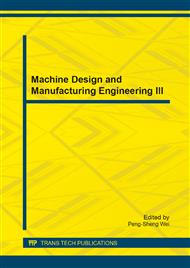[1]
J. Jurko, Study changes in tool wear of stainless steels ELC X01Cr18Ni10Ti when drilling, Advanced Materials Research, Vol. 785-786, No. 785-786, 2013, pp.1005-1008.
DOI: 10.4028/www.scientific.net/amr.785-786.1005
Google Scholar
[2]
J. Jurko, Changes in mechanical properties of cast iron GTW 35-04 under the surface parameter during drilling, Applied Mechanics and Materials, Vol. 404, No. 404, 2013, pp.86-90.
DOI: 10.4028/www.scientific.net/amm.404.86
Google Scholar
[3]
J. Jurko, Manufacturing accuracy when drilling holes in stainless austenitic steels DIN 1. 4301, Applied Mechanics and Materials, Vol. 420, No. 420, 2013, pp.250-253.
DOI: 10.4028/www.scientific.net/amm.420.250
Google Scholar
[4]
J. Jurko, A. Panda, M. Behún, Study changes in mechanical properties of stainless steels ELC X04Cr14Ni12TiN, Applied Mechanics and Materials, Vol. 420, No. 420, 2013, pp.250-253.
DOI: 10.4028/www.scientific.net/amm.378.150
Google Scholar
[5]
J. Jurko, A. Panda, M. Behún, I. Mrkvica, Prediction of selected aspects of machinability of austenitic stainless steels, Advanced Materials Research, Vol. 739, No. 739, 2013, pp.206-209.
DOI: 10.4028/www.scientific.net/amr.739.206
Google Scholar
[6]
J. Jurko, A. Panda, M. Behún, I. Mrkvica, Prediction of selected aspects of machinability of austenitic stainless steels, Advanced Materials Research, Vol. 739, No. 739, 2013, pp.206-209.
DOI: 10.4028/www.scientific.net/amr.739.206
Google Scholar
[7]
J. Jurko, A. Panda, M. Behún, "Prediction of a new form of the cutting tool according to achieve the desired surface quality, Applied Mechanics and Materials, Vol. 268 (PART 1), No. 268, 2013, pp.473-476.
DOI: 10.4028/www.scientific.net/amm.268-270.473
Google Scholar
[8]
J. Jurko, A. Panda, M. Behún, Prediction of ploughing effect phenomena in the cutting zone during the drilling of X5Cr18Ni9 stainless steel, Advanced Materials Research, Vol. 739, No. 739, 2013, pp.201-205.
DOI: 10.4028/www.scientific.net/amr.739.201
Google Scholar
[9]
J. Jurko, A. Panda, M. Behún, J. Gecák, Effect of machinability of stainless steels for increasing of productivity production, Applied Mechanics and Materials, Vol. 378, No. 378, 2013, pp.154-158.
DOI: 10.4028/www.scientific.net/amm.378.154
Google Scholar
[10]
J. Jurko, A. Berdis, J. Panda, J. Gecák, J. Nemcová, Study of changes the tool wear of the cutting tool part of a new cast iron GTW 35-04 during drilling, Applied Mechanics and Materials, Vol. 404, No. 404, 2013, pp.82-85.
DOI: 10.4028/www.scientific.net/amm.404.82
Google Scholar
[11]
J. Jurko, A. Panda, M. Gajdoš, Accompany-ing phenomena in the cutting zone machinability during turning of stainless steels,. International Journal Machining and Machinability of Materials, Vol. 5, No. 4, 2009, pp.383-400.
DOI: 10.1504/ijmmm.2009.026899
Google Scholar
[12]
J. Jurko, Verification of cutting zone machinability during drilling of austenitic stainless steels, ICEM 2008: International Conference on Experimental Mechanics SPIE, Vol. 7375, No. 7375-1H, 2008, pp.367-378.
DOI: 10.1117/12.839061
Google Scholar
[13]
E.W. Brinksmeier, A. Reucher, J. Griet-Solter, Influence of characteristic material properties on machinability under high speed cutting, International Journal of Machining and Machinability of Materials, Vol. 4, No. 4, 2008, pp.419-428.
DOI: 10.1504/ijmmm.2008.023723
Google Scholar
[14]
J. Jurko, M. Džupon, A. Panda, M. Gajdoš, I. Pandová, Deformation of material under the machined surface in the manufacture of drilling holes in austenitic stainless steel,. Chemical. Letters, Vol. 105, No. 16, 2011, pp.600-602.
Google Scholar
[15]
S. Dolinšek, Work-hardening in the drilling of austenitic stainless steels, Journal of Materials Processing Technology, Vol. 133, No. 1, 2, 2003, pp.63-70.
DOI: 10.1016/s0924-0136(02)00245-5
Google Scholar


